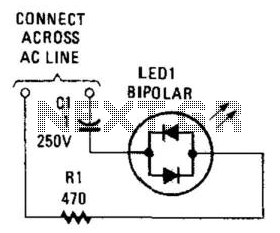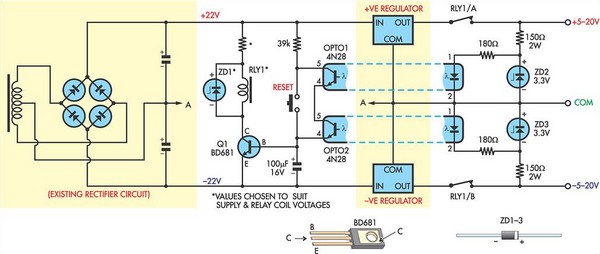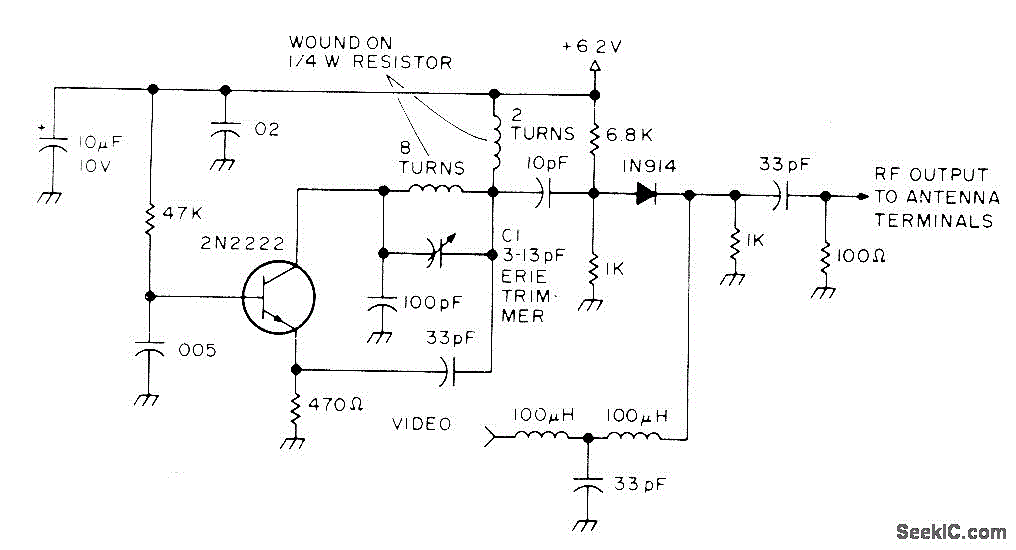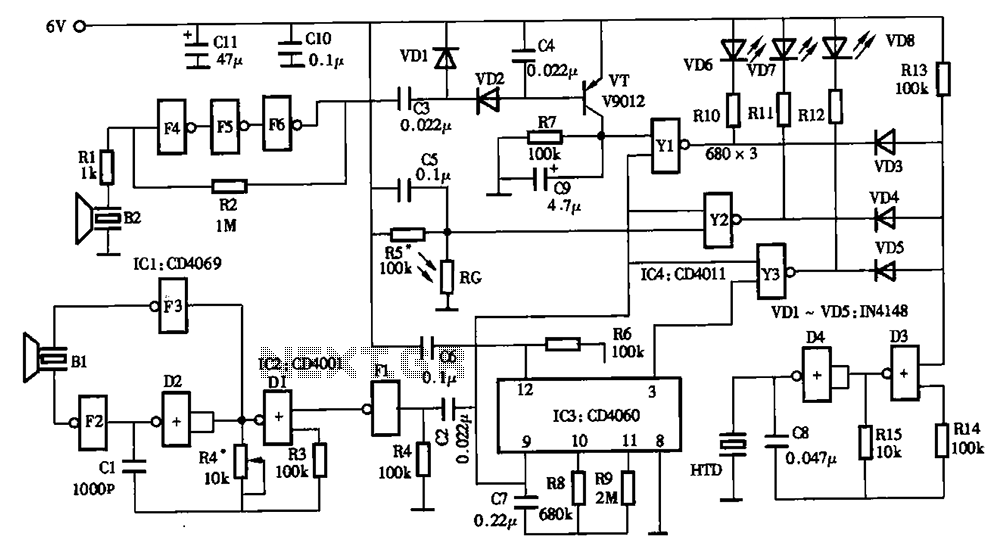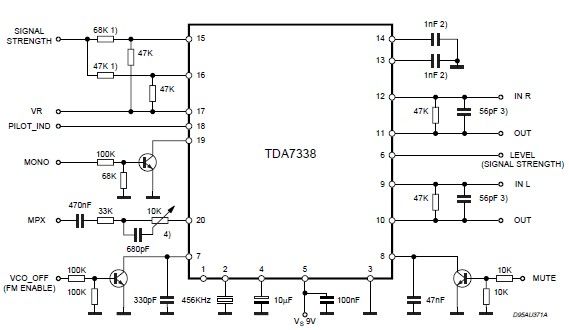
555 as the core of a circuit diagram of proximity switch
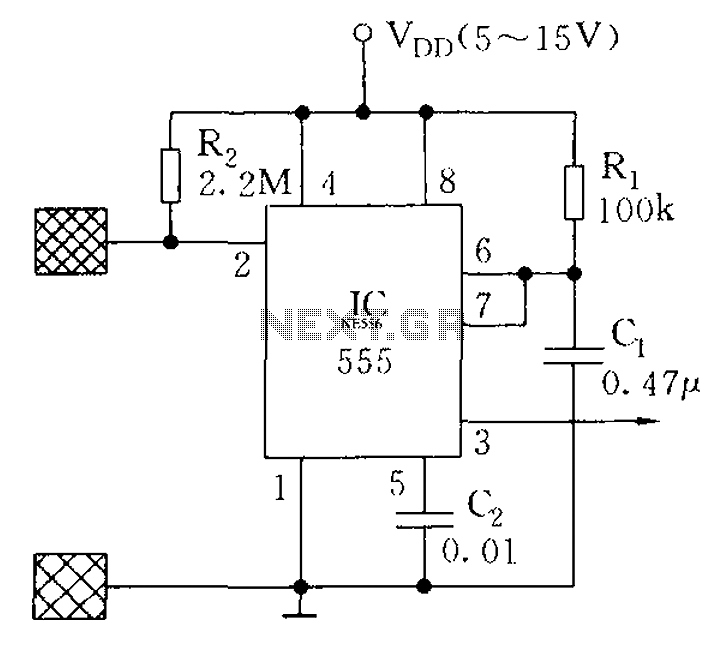
The proximity switch using the 555 timer functions as a monostable trigger circuit. The trigger pin (Pin 2) of the 555 timer is connected through a large resistor (R2) to the positive supply voltage (VDD) and is in a standby state, awaiting a trigger condition. When a body approaches or touches the metal plate electrodes, the sensor signal activates the 555 timer, resulting in a one-shot pulse output. Capacitor C2 is used for filtering interference. This circuit is suitable for applications in electrical appliances, toys, or alarm systems.
The circuit utilizes the 555 timer IC, a versatile and widely used component in various electronic applications. In the monostable configuration, the 555 timer generates a single output pulse of a specified duration in response to an external trigger. The duration of the pulse is determined by the resistor (R1) and capacitor (C1) values, following the formula T = 1.1 * R1 * C1, where T is the pulse width.
In this design, R2 serves to pull the trigger pin (Pin 2) high, ensuring that the circuit remains inactive until a triggering event occurs. The metal plate electrodes act as the sensing mechanism, detecting the presence of a nearby object, such as a hand or body. Upon detection, the electrodes generate a low signal that is fed to Pin 2, causing the 555 timer to switch from its stable state to an active state, producing a high output pulse.
Capacitor C2 plays a crucial role in filtering out any noise or interference that may affect the signal integrity. By smoothing out voltage fluctuations, C2 helps to ensure that the output pulse is clean and reliable. This feature is particularly important in environments where electromagnetic interference may be present.
The output from the 555 timer can be used to control various devices, such as relays, LEDs, or other components, enabling the circuit to function as an activation mechanism for electrical appliances, toys, or alarm systems. This flexibility makes the proximity switch circuit a valuable addition to many electronic projects, providing a simple yet effective means of detecting proximity and triggering actions accordingly. As shown, the proximity switch 555 as the core component monostable trigger circuit. 555 Trigger Pin 2 through the large resistance R2 connected to VDD, is waiting for a trigge r condition. When the body close to or touch the metal plate electrodes, since the sensor signal 555 is triggered, a one-shot pulse output. C2 filtering for interference. The circuit can be used for electrical appliances, toys or alarm circuit.
The circuit utilizes the 555 timer IC, a versatile and widely used component in various electronic applications. In the monostable configuration, the 555 timer generates a single output pulse of a specified duration in response to an external trigger. The duration of the pulse is determined by the resistor (R1) and capacitor (C1) values, following the formula T = 1.1 * R1 * C1, where T is the pulse width.
In this design, R2 serves to pull the trigger pin (Pin 2) high, ensuring that the circuit remains inactive until a triggering event occurs. The metal plate electrodes act as the sensing mechanism, detecting the presence of a nearby object, such as a hand or body. Upon detection, the electrodes generate a low signal that is fed to Pin 2, causing the 555 timer to switch from its stable state to an active state, producing a high output pulse.
Capacitor C2 plays a crucial role in filtering out any noise or interference that may affect the signal integrity. By smoothing out voltage fluctuations, C2 helps to ensure that the output pulse is clean and reliable. This feature is particularly important in environments where electromagnetic interference may be present.
The output from the 555 timer can be used to control various devices, such as relays, LEDs, or other components, enabling the circuit to function as an activation mechanism for electrical appliances, toys, or alarm systems. This flexibility makes the proximity switch circuit a valuable addition to many electronic projects, providing a simple yet effective means of detecting proximity and triggering actions accordingly. As shown, the proximity switch 555 as the core component monostable trigger circuit. 555 Trigger Pin 2 through the large resistance R2 connected to VDD, is waiting for a trigge r condition. When the body close to or touch the metal plate electrodes, since the sensor signal 555 is triggered, a one-shot pulse output. C2 filtering for interference. The circuit can be used for electrical appliances, toys or alarm circuit.
